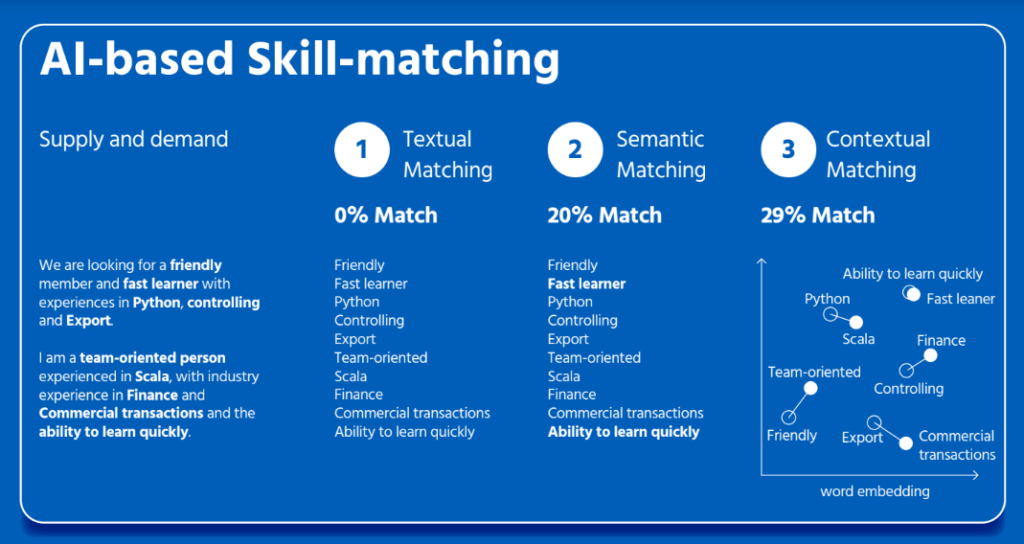
What are the benefits of a skills ontology?
January 4, 2023
A dynamic AI skills-ontology platform can help you know which skills you have within your organization and the skills you need both now and in the future. Combining these two datasets means you can see the skills gaps for individuals, teams, and the whole organization, thus allowing you to focus on closing that gap by providing relevant, personalized learning experiences.
As mentioned in our previous blog, ‘Finding your superpower: What is a skills ontology?’, trying to create a skills framework for your organization manually is tough enough, but trying to keep it up to date in today’s fast-moving world is almost impossible. Josh Bersin suggests that there are two ways to solve this problem: “Define an organization, job, and skills model and then use software to ‘apply it to your company,’” and “Develop a system that ‘self-describes’ the work, skills, and capabilities you need to succeed.”
The latter allows your ontology to be constantly evolving, meaning it can keep pace with changes in the market. Using AI in this way to do the heavy lifting of keeping the ontology up to date frees up time to focus on the bits humans do best—coaching, mentoring, and creating effective learning experiences.
So, how exactly does this work?
Most skills-management platforms use either humans or machines to create and keep their ontology up to date. Here at Learning Pool, we use a combination of both.
At the time of writing, our ontology includes more than 21,000 unique skills (40,000 if we include synonyms). Each of these is referenced in terms of how they relate to 2,500 unique job titles (100,000 if we include synonyms). Each skill is then translated into our core languages. The AI is continually (every single day—no time off needed, unlike us humans!) scanning relevant sources across the globe, including job adverts and a variety of publicly available skills and job taxonomies. It is looking for new skills and checking for trends in terms of whether demand for a particular skill or job is rising or falling. In addition, the organization and users can suggest new skills to be added on a continuous basis.
If a new skill is detected, then it is passed to our human skills curators who verify it and check whether it is a synonym for an existing skill (leading to a 100% match—pairing “Fast Learner” and “Ability to Learn Quickly” is one example). If it isn’t, the AI will calculate the skill relation (skill similarity) between this new skill and the other 20,000 skills. For example, “Friendly” is not a synonym for “Team Oriented,” but they have a close connection that will have an impact on the matching score. Our ontology even supports the integration of client-specific taxonomies, so if you have a “hard-coded” version, we will use this taxonomy, embed it in our ontology, and ensure the same method of operation as with all the other skills.

This combination of human and machine learning means you can be confident that the ontology is always up to date and accurate, ensuring a high quality of skill extraction and matching.
Using a skills ontology for staff engagement and retention
Staff engagement and retention are vital for organizations in this fast-changing world. They save on recruitment costs, improve organizational morale and productivity, and reduce the time and cost of training and retraining.
According to Gallup’s U.S. Employee Engagement Data, in 2021 “36% of U.S. employees are engaged in their work and workplace” and globally “20% of employees are engaged at work.” So globally only 1 in 5 employees are truly committed to their organization.
Building skills helps with staff retention. Employees are more engaged when they feel like their employer and manager are supporting and investing in their growth and development. It is therefore vital to have leaders and managers who can provide ongoing, personalized skills development to employees and for those leaders and managers to be able to see where the skills gaps and opportunities are.
With many emerging roles and teams often having to adapt at speed to meet changing business objectives, it can be difficult for people to see career-progression pathways. Skills-management systems can help by enabling employees to:
- Analyze their own skills
- See what skills they need to build to succeed in their current role
- See the skills they need to progress to their future role—whether this is a direct next step within the same team or moving to an entirely different part of the organization
Skills-management systems can even suggest possible career pathways that employees hadn’t previously considered, based on skill matching. Gone are the days of plodding up the same vertical career ladder—transferable skills are key to flexibility in our organizations and allow them to adapt, grow, and thrive.
Putting the power of skills management in the hands of all employees enables them to see where they can progress in their current organization rather than feeling they need to move to another organization to achieve their ambitions.
Another benefit of skills management is that it allows personalized onboarding by ingesting a new starts resume and the job specification they have just been hired for, and both they and their manager can immediately see which skills they need to work on. The learning platform will recommend the best learning experiences to do this, which means employees feel valued and invested in from the very start, and the organization immediately gains an engaged employee with a learning and personal-growth mindset.
To discover more of the benefits of an ontology-based skills management system, take a look at our latest whitepaper, ‘Skills are your organization’s superpower’.
Got a learning problem to solve?
Get in touch to discover how we can help

